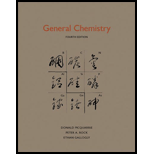
Concept explainers
Interpretation:
The number of ions produced per formula unit when the indicated substance is dissolved in aqueous solution to produce a
| Formula | |
Concept Introduction:
Freezing point depression:
The lowering of the vapor pressure of a solvent by a solute leads to a lowering of the freezing point of the solution relative to that of the pure solvent. This effect is called as the freezing point depression. The mathematical relationship is given below.
Where,
Answer to Problem 16.91P
The number of solute particles per formula unit of
Explanation of Solution
The value of
For
Given that, the freezing point depression of a
Now, using the freezing point depression expression, the van’t Hoff factor for
Therefore, the number of ions produced per formula unit of
For
Given that, the freezing point depression of a
Now, using the freezing point depression expression, the van’t Hoff factor for
Therefore, the number of ions produced per formula unit of
For
Given that, the freezing point depression of a
Now, using the freezing point depression expression, the van’t Hoff factor for
Therefore, the number of ions produced per formula unit of
For
Given that, the freezing point depression of a
Now, using the freezing point depression expression, the van’t Hoff factor for
Therefore, the number of ions produced per formula unit of
For
Given that, the freezing point depression of a
Now, using the freezing point depression expression, the van’t Hoff factor for
Therefore, the number of ions produced per formula unit of
| Formula |
Number of ions produced per formula unit |
Want to see more full solutions like this?
Chapter 16 Solutions
General Chemistry
 ChemistryChemistryISBN:9781305957404Author:Steven S. Zumdahl, Susan A. Zumdahl, Donald J. DeCostePublisher:Cengage Learning
ChemistryChemistryISBN:9781305957404Author:Steven S. Zumdahl, Susan A. Zumdahl, Donald J. DeCostePublisher:Cengage Learning ChemistryChemistryISBN:9781259911156Author:Raymond Chang Dr., Jason Overby ProfessorPublisher:McGraw-Hill Education
ChemistryChemistryISBN:9781259911156Author:Raymond Chang Dr., Jason Overby ProfessorPublisher:McGraw-Hill Education Principles of Instrumental AnalysisChemistryISBN:9781305577213Author:Douglas A. Skoog, F. James Holler, Stanley R. CrouchPublisher:Cengage Learning
Principles of Instrumental AnalysisChemistryISBN:9781305577213Author:Douglas A. Skoog, F. James Holler, Stanley R. CrouchPublisher:Cengage Learning Organic ChemistryChemistryISBN:9780078021558Author:Janice Gorzynski Smith Dr.Publisher:McGraw-Hill Education
Organic ChemistryChemistryISBN:9780078021558Author:Janice Gorzynski Smith Dr.Publisher:McGraw-Hill Education Chemistry: Principles and ReactionsChemistryISBN:9781305079373Author:William L. Masterton, Cecile N. HurleyPublisher:Cengage Learning
Chemistry: Principles and ReactionsChemistryISBN:9781305079373Author:William L. Masterton, Cecile N. HurleyPublisher:Cengage Learning Elementary Principles of Chemical Processes, Bind...ChemistryISBN:9781118431221Author:Richard M. Felder, Ronald W. Rousseau, Lisa G. BullardPublisher:WILEY
Elementary Principles of Chemical Processes, Bind...ChemistryISBN:9781118431221Author:Richard M. Felder, Ronald W. Rousseau, Lisa G. BullardPublisher:WILEY





